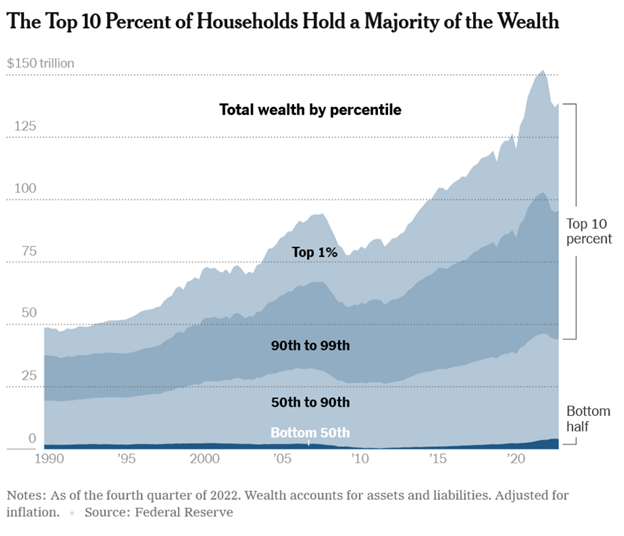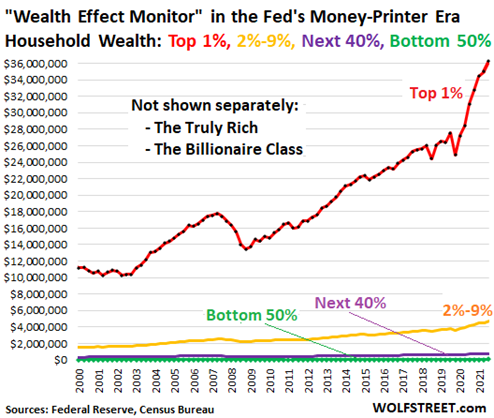The Daily Escape:

We’ve been on Cape Cod for a few days visiting daughter Kelly. Here’s a sunset photo taken this week at Campground beach, Cape Cod, MA – August 2023 iPhone photo by Wrongo. Smoke from Canadian wildfires made the sunset colors more vibrant.
Welcome to our Saturday Soother! But first, let’s talk about the coming generational transfer of wealth that’s underway as the wealthiest generation (the boomers) retire. According to Ben Carlson, 10,000 baby boomers will be retiring every day between now and the end of this decade.
The first boomers were born in 1946, meaning they’re 77 and on the fast track to 80 years old. Fortune Magazine pegs the wealth transfer from boomers to their kids at $73 trillion (with another $12 trillion going to charity). That means the boomers have $85 trillion in personal wealth!
That sounds great, since so many in our younger generations really could use a little help right now. But fewer people than you might expect will actually receive a sizable inheritance. This is due to the fact that the top 10% of America’s wealthy own something like 90% of the stock market. The concentration of today’s wealth will lead to fewer people benefiting from the generational handoff.
Here’s a chart from the NYT:

According to the NYT, ultra-high net worth households — people with $5 million to $20 million in liquid net worth — make up 1.5% of the population but will constitute 42% of the money that gets passed down in the years ahead. Many of them are boomers. From the NYT:
“A key reason there are such large soon-to-be-inherited sums is the uneven way boomers superbly benefited from price growth in the financial and housing markets. The average price of a US house has risen about 500% since 1983, when most baby boomers were in their 20s and 30s, prime years for household formation.
As US corporations have grown into global behemoths, those deeply invested in the stock market have found even bigger returns: The stock market, as measured by the benchmark S&P 500 index, is up by more than 2,800% since the beginning of 1983…”
Those rates of growth in financial and real estate assets will probably never be seen again. We’re passing a slow growth economy on to the next generations, while their own salaries and savings are having trouble keeping up with inflation.
Some worry that retiring baby boomers will crash the stock market by spending down their portfolios in retirement, leaving nothing to inherit. While it could happen, it’s unlikely that it will. The inequality of stock ownership means few people in the top 10% will never come close to spending all of their wealth in retirement.
So the wealth transfer will be more of a stream than a tsunami. Given the longevity of the wealthy, the money is going to be passed down slowly over time. A married couple that is retiring today has a 50% chance of at least one spouse living into their 90s.
Wrongo sees more and more people in the younger generations talking about how much they need help from their parents right now rather than decades down the road. The challenge is that parents need to be sure that if they make early transfers of wealth, that they keep enough on hand to maintain themselves securely in their advancing old age.
This can only be done by families having honest discussions around very awkward subjects. Talking about it can be helpful. It may be possible to work something out where some of the inheritance is parsed out slowly so the parents can enjoy seeing the kids (or grandkids) use some of the money while they’re still here.
Enough! It’s time for our Saturday Soother, where we ignore the also-ran candidate show that the Republicans put on in Wisconsin, and where we also ignore the perp walk in Atlanta. Instead, let’s focus on clearing our heads for next week’s outrages.
To help clear your head, grab a comfy chair by a window, and pour a mug of cold brew over ice. Now, watch and listen to Beethoven’s “Septet, op. 20”. It had its first performance in 1800 and was one of Beethoven’s most popular works during his lifetime, much to the composer’s dismay! He ultimately wished he had never written the piece.
Today we listen to the first movement, “Adagio – Allegro con brio” played in 2014 by the WDR Symphony Orchestra in Cologne, Germany. The WDR is a German radio orchestra:




